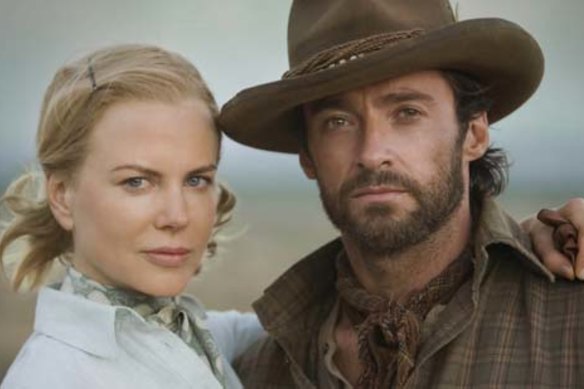In this column, we deliver hot (and cold) takes on pop culture, judging whether a subject is overrated or underrated.
Save articles for later
Add articles to your saved list and come back to them any time.
Ask 10 Australian film fans their view of Baz Luhrmann and you will probably get 11 opinions.
Opinion one: the Australian director is a visionary genius who keeps redefining cinema genres.
Opinion two: he makes films that are over-the-top, flamboyant and hollow.
Opinion three: Luhrmann has made some of this country’s most inventive and successful films, with five of the top 12 Australian hits at the domestic box office.
Opinion four: he is self-indulgent, and over-rated and his wife, four-time Oscar-winning designer Catherine Martin, is the real talent in the family. And so on.
Nicole Kidman and Hugh Jacknam in Baz Luhrmann’s Australia.
Luhrmann has polarised reviewers since he made Strictly Ballroom (1992) which he followed up with Romeo and Juliet (1996), Moulin Rouge! (2001), The Great Gatsby (2013) and Elvis (2022).
But his worst reviews were for Australia (2008), his romantic wartime epic that had Nicole Kidman as Lady Sarah Ashley and Hugh Jackman as the rugged Drover. If most critics are to be believed, it was a disastrous attempt to make an Australian Gone With The Wind.
Here is a sample of the stinging reviews:“a crazy mess” (Stephanie Zacharek, Salon); “Luhrmann is drawn to kitsch as inevitably as a bear to honey” (David Denby, The New Yorker); “one wonders if there are any cliches about Australia that have been missed” (Jim Schembri, The Age); “a melodramatic exercise in tedium” (Claudia Puig, USA Today); “the solemnity of the film sets like concrete (Peter Bradshaw, The Guardian) and “feels like being pinned down by a giant over-friendly dingo and having your face licked for about three hours” (Liam Lacey, The Globe and Mail).
The haters included one worked-up character at a film industry conference who argued that it shouldn’t even be considered an Australian film – and therefore eligible for federal and state filmmaking incentives – because it was backed by Hollywood studio Twentieth Century Fox.
On a panel at the time, I politely pointed out that it was written by Australians, directed by Australians, starred Australians, had a story full of Australian archetypes that was set in Australia, was shot in Australia by an Australian crew and was even called Australia. How much more Australia do you want?
I’ll admit it was not my favourite Luhrmann film when it came out. I thought it fell short of the dynamic energy, heart and charm of Strictly Ballroom, the dazzling style and romance of Romeo and Juliet and, even if many critics teed off again, the ambition, heartfelt romance and brilliant use of pop songs in Moulin Rouge!
It felt as though Luhrmann’s struggle to finish Australia in time for a cinema release he virtually begged Fox to delay left it feeling uneven. Some of the visual effects felt unfinished, especially in the cattle stampede, and the shifts in tone felt awkward.
The Fox marketing build-up – suggesting it would be a masterpiece that would knock off Titanic as the highest-grossing film in Australian cinema history – raised the bar too high. So did high-profile marketing deals with the likes of Qantas, the Nine and Ten networks, R.M. Williams, News Corporation newspapers and Australian winemakers.
Before a new edit of what Luhrmann says was more than two million feet of film turned into the six-chapter series Faraway Downs, which streams on Disney + from November 26, I’m here to defend Australia.
I’ll stand on a soapbox to declare that it is a better film – a much better film – 15 years on. Watching it now, the comedy, romance, tonal shifts and VFX are all more effective.
Even the scene that had a shirtless Jackman rinsing off with a bucket – the subject of much lusty comment and equal parts mocking at the time – works better.
It might be that Luhrmann has tightened the film and improved the VFX since the first Australian screenings. That’s very possible given he returned to the edit suite for Faraway Downs.
It’s also moving to see so many much-loved actors who are no longer with us, including David Gulpilil, Tony Barrie, Ray Barrett, David Ngoombujarra and Arthur Dignam.
But what’s most impressive is the way Luhrmann used a huge Hollywood budget to tell a touching story of stolen generations centering on Nullah, beautifully played by Brandon Walters. The film works through the arguments about the treatment of a boy with an Aboriginal mother and white father and comes down on the side of Culture and Country.
You have to admire the ambition of Australia: Luhrmann aimed for absolutely everything. Even if he only reached most things, that’s a lot more than most artists achieve.
And despite what critics thought, Australian audiences went for it. Its box office take ($37.6 million) is second only among Australian films to Crocodile Dundee ($47.7 million).
It’s time to give Australia credit. It’s a much better and much more thoughtful film than you probably remember.
To read more from Spectrum, visit our page here.
Find out the next TV, streaming series and movies to add to your must-sees. Get The Watchlist delivered every Thursday.
Most Viewed in Culture
From our partners
Source: Read Full Article



